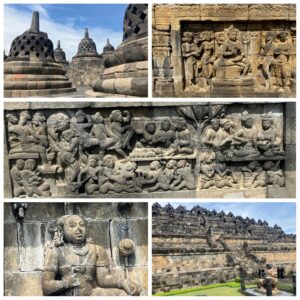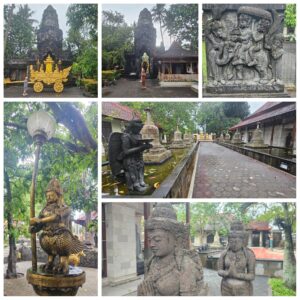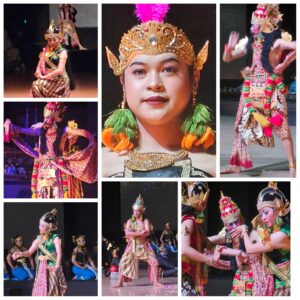The timeless mountain of the Buddha

When I first visited Borobudur in the late 1980s, the great monument stood quietly in the middle of rice fields, without fences, shuttle buggies, or crowds. I could walk freely to the top, sitting among the stupas with hardly another visitor in sight. Today, the setting has changed dramatically — a vast landscaped park now surrounds the UNESCO World Heritage Monument, and small electric buggies carry visitors from the entrance to the site. Entry is strictly timed, and climbing to the top is no longer allowed, after years of over-enthusiastic tourists and even graffiti left their marks. Yet the monument itself has not changed; the volcanic stone feels eternal, and its message of serenity endures as strongly as ever.
Set within a dramatic volcanic landscape, Borobudur lies between the twin volcanoes Merapi and Merbabu to the east and the Menoreh hills to the south, a setting chosen with cosmological precision. Built in the 8th and 9th centuries by the Buddhist Sailendra dynasty, the monument represents a spiritual map in stone: nine stacked terraces symbolising the stages of enlightenment. From above, its perfect mandala form reveals the monument’s deeper meaning — a three-dimensional expression of the Buddhist universe, uniting geometry, spirituality, and landscape. Over 2,600 carved reliefs tell stories from the Buddha’s life, while the upper terraces hold 72 bell-shaped stupas surrounding a vast central dome. Once, more than 200 smaller shrines stood around it, forming an immense sacred landscape. Most of these are now only ruins, but they hint at the monument’s original splendour. The UNESCO restoration of the late 1970s and early 1980s — just before my first visit — was a monumental feat, saving Borobudur from collapse and re-establishing it as one of Asia’s most important cultural treasures.
The calm before Borobudur – Mendut and Pawon

The day before our visit, we stopped at Mendut Monastery, a serene oasis shaded by banyan trees and set between gardens and lotus ponds, maintaining the rhythm of a living Buddhist community. Mendut Temple itself, with its majestic, seated Buddha, forms a perfect alignment with Pawon Temple and Borobudur — a sacred east–west axis that likely guided ancient pilgrims along a processional route of prayer and meditation. Unlike Borobudur and Prambanan, which are now historical monuments, Mendut remains a working monastery — a rare surviving link to the living Buddhist traditions of Java’s past.
Prambanan – where the gods rise from stone

The next day we travelled the forty kilometres east to Prambanan. While Borobudur is massive and earth-bound, Prambanan is light and vertical, its towers rising like slender spears against the grey sky. Built in the mid-9th century by the Hindu Sanjaya dynasty, Prambanan honours the Trimurti — Shiva, Vishnu, and Brahma — with the 47-metre Shiva temple at its centre. During our visit, low clouds lingered over the plain and the rain left a glistening sheen on the stone, giving the temple complex an almost otherworldly quality.

We explored the inner courtyards and entered the three main temples, where in near darkness the statues of the deities stand in silent majesty — Shiva, Brahma, and Vishnu illuminated only by the faint light filtering from the doorway and the torch of the guide. Later that evening, we enjoyed dinner in view of the illuminated temples and after that we attended the Ramayana Ballet. Normally performed in an open-air theatre with the temples as a backdrop, the show was moved indoors because of the rain, but it remained just as captivating. The performance combined Javanese dance, elaborate costumes, and a live gamelan orchestra to retell the story of Rama and Sita — the eternal struggle between good and evil, love and sacrifice — a tale that has travelled through the centuries and is still told with grace and precision.
From Buddhism to Hinduism – a dynastic shift
The close proximity of Borobudur and Prambanan, both built within a few generations, reflects the dynastic and religious changes of early Central Java. The Sailendra rulers were devout Buddhists, while their successors, the Sanjaya kings, promoted Hinduism, particularly the worship of Shiva. This change was less a religious conversion among the people than a shift in royal patronage and political alliances. The two faiths coexisted peacefully for a time, and their temples reflect both artistic exchange and dynastic rivalry.
Engineering faith – the scale of construction
Standing before either monument, one cannot help but wonder at the sheer human effort behind them. Each structure required tens of thousands of stone blocks quarried from the surrounding volcanic landscape, transported, carved and set in place without mortar. Thousands of individually carved relief panels tell continuous narrative cycles, carrying moral and spiritual lessons that remain recognisable today. The work required immense organisation and logistics, coordinated across a vast labour force. Construction took place over at least three successive reigns—continuity on a scale difficult to imagine—drawing on thousands of skilled artisans, labourers and craftsmen. While there is no evidence of slavery, corvée labour (mandatory service owed to the ruler) was almost certainly used. These monuments represent an extraordinary level of cultural achievement: engineering, labour management and artistic vision working together to express an entire civilisation’s understanding of the cosmos in stone.
The fading of a civilisation
By the 10th century, Central Java’s political power shifted eastward, possibly due to volcanic eruptions, floods, or dynastic change. The once-great temple culture declined, and over the centuries, Islam became the dominant faith. The great monuments fell into silence, covered by jungle and ash, until their rediscovery in the 19th century. What remains today are masterpieces of an age that combined faith, knowledge, and artistry — reminders of a civilisation that reached astonishing heights of creativity and organisation.
Across Southeast Asia
A few years ago, we visited Angkor Wat in Cambodia, and the parallels are unmistakable. Like Borobudur and Prambanan, Angkor represents an attempt to recreate the universe in stone — a blend of spiritual devotion, political power, and artistic mastery. These monuments, scattered across Southeast Asia, show how deeply interconnected the region once was, sharing ideas, architecture, and inspiration.
Tracing Dutch Batavia: From the Old City to Buitenzorg
Exploring Java’s Colonial Legacy: Bandung, Cimahi, Yogyakarta and Surabaya
The Moluccas: Islands of Spice, Memory and Continuity
Kapitan Pattimura (Thomas Matulessy) and the 1817 Maluku Uprising
The Long Road to Independence: From Colonial Resistance to the Birth of Indonesia
Ramayana Ballet